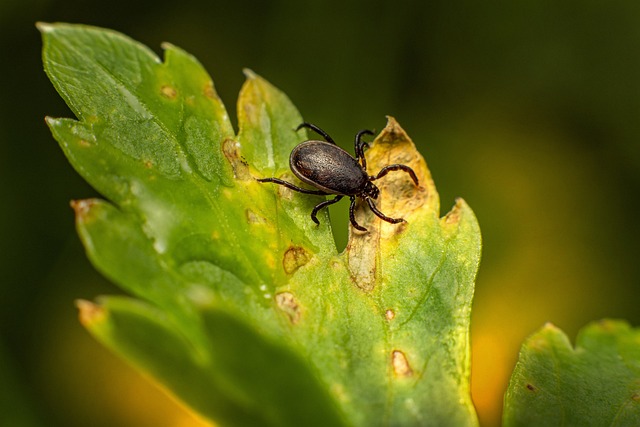While in Wales this May Alan and I both got bitten by ticks – this was a first for both of us! I was bitten once and him twice, all in one week. While we were completely unprepared for this, we were lucky in that we found them (we believe) very soon after they had buried their little heads into our flesh, so they were really easy to remove! There are lots of little tick removal gadgets out there, but the only thing we had was a good old-fashioned pair of eyebrow tweezers, which fortunately did the trick.

Tick Basics
Ticks are small, spider-like creatures that feed on the blood of animals, including humans. In fact, they are in the arachnid family. There are approximately 20 species of ticks in the UK. Of these, the sheep tick is the most common species to bite humans.
Tick numbers have risen over the years and are now much more common across the UK than in past. This is mainly due to an increase in the number of deer in the country.
Tick Habitats
Ticks tend to live in tall grasses, moorlands and heathlands, and woods. Their “season” generally begins in March, hits its peak in the mid-summer months, and goes on until October. Once indoors, they don’t tend to live long. This was much to my relief! I had visions of little tick babies hatching inside and plaguing us for ages – but this won’t happen! However, do bear in mind: scan your clothing for ticks when you get in from the outdoors. Washing your clothes will not kill them (tumble drying them apparently does) so they may have the chance to latch onto you next time you put on those washed trousers!
Health Risks
Ticks can transmit diseases, with some pretty awful consequences. Lyme disease is the main concern over tick bites and although it can be nasty, it is very treatable, particularly when caught early. And while it is important to be “tick aware”, it is also important not to panic. On average, only about 4% of ticks in England and Wales carry Lyme Disease. If you are bitten, please do be aware of the symptoms below and always contact 111, your GP, or a healthcare professional if you are concerned.
Here are some key points about the 2 main diseases ticks may transmit:
- Lyme Disease: Ticks are notorious carriers of Lyme disease. When an infected tick bites, it can lead to Lyme disease. The longer an infected tick remains in your flesh, the more chance it has of infecting you. Early symptoms include fever, fatigue, and a characteristic “bull’s-eye” rash. This rash does not always appear, but if it does it can happen any time 3-30 days after being bitten. If left untreated, Lyme disease can cause serious complications.
- Tick-Borne Encephalitis (TBE): Although less common in the UK, an increasing number of cases have been recorded. TBE is a viral infection transmitted by ticks. It can affect the nervous system and lead to severe symptoms. Early symptoms include fever, fatigue, aches, and nausea and/or vomitting.
Staying Safe
Consider these points to protect yourself from tick bites:
- Be Tick Aware: Be cautious when walking in woodland, grassy areas, and heathlands. This includes wearing long sleeves and trousers, and tucking trousers or leggings into your socks. You can also wear a tick-repellent such as Jungle Formula (contains DEET), Trek (DEET free) or Smidge (DEET free).
- Tick Checks: After spending time outdoors, first check your clothes, then check your body (especially warm areas like armpits, groin, and scalp) for ticks. Prompt removal reduces the risk of disease transmission.
- Tick Surveillance Scheme: You can contribute to tick research by participating in the UK Health Security Agency’s Tick Surveillance Scheme. See the UK Gov website for more info.
Tick Removal
Even when we are aware of how to prevent a tick bite, they still happen! I am no expert on the removal of ticks and am pretty sure I just fluked removing our 3 without issue. But I DO know that you should NOT: cover them in Vaseline or try to burn/singe them off!
There are several gadgets available to aid you in getting a grip on your tick to remove it. Some look like credit cards with a “V” shape cut in the corners and others are “Y” shaped tools. Both are designed for you to slide them up close to the tick’s head before using them as a lever to the pull the tick out. Sort of like the nail-removing end of a hammer.
Although my eyebrow tweezers worked fine, the long and pointy tick tweezers help prevent you from squishing the tick, causing it to “vomit” and release its toxins back into your body. Gross. The proper way to remove them is getting as close to the head as possible and pull gently up and in the direction of the tick’s body. It’s important not to twist as you do this, to help keep the tick’s head attached to it’s body.
We currently have a “Y” shaped tick remover and a pair of tick tweezers in our Amazon basket as I type, so we are better prepared for the next time!
Keep getting outside and enjoying our wild spaces, but remember to also be vigilant and protect yourself, your pets, and your loved ones!
I’m no GP or health care professional, just some one with a bit of experience and knowledge who spends a lot of time outdoors! For more information on ticks, Lyme Disease, etc. check out the NHS, UKHSA and UK Government websites.
I hope you have found this helpful! Please drop a comment below if you have any questions or suggestions.